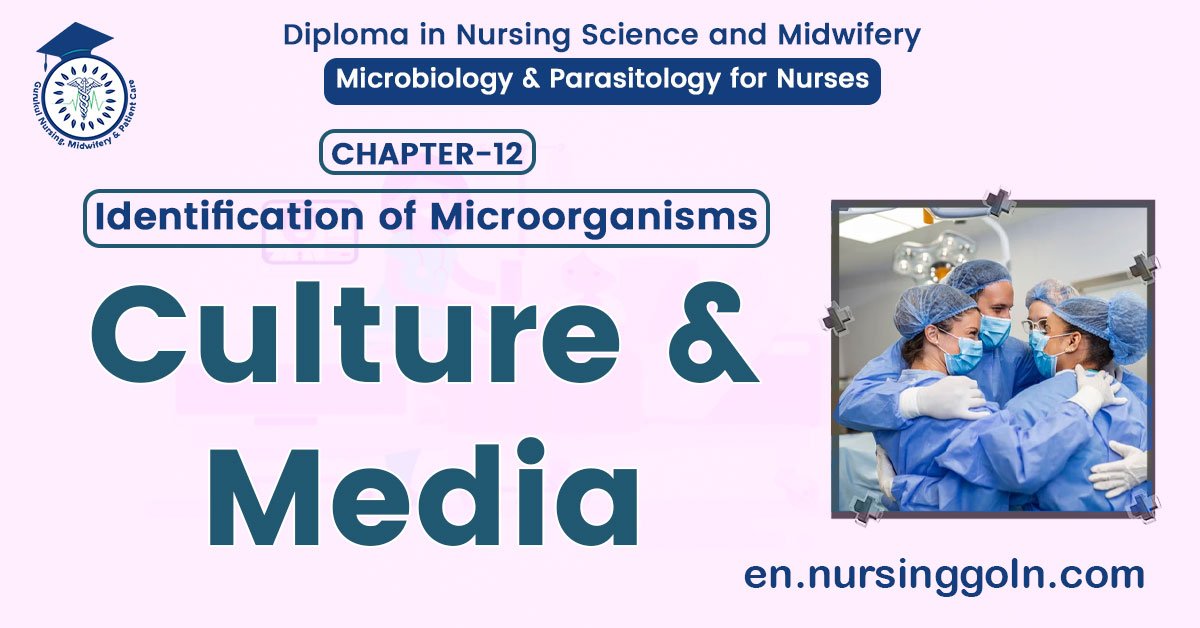Culture and Media – Basic microbiology, parasitology, and immunology; nature, reproduction, growth, and transmission of common microorganisms and parasites in Bangladesh; prevention including universal precaution and immunization, control, sterilization, and disinfection; and specimen collections and examination. Students will have an understanding of common organisms and parasites caused human diseases and acquire knowledge about the prevention and control of those organisms.
Culture and Media
Culture is the artificial process of cultivation of microbes by providing the proper environmental condition.
Or
Culture is the term given to microorganisms that are cultivated in the lab for the purpose of identifying and studying them.

Definition of Bacterial Culture Media/Culture media
Media may be defined as an artificial food for the cultivation of bacteria in the laboratory.
Or
Medium is the term given to the combination of ingredients that will support growth and cultivation of microorganisms by providing all the essential nutrients required for the growth.
Example:
- Mac Conkey’s agar medium.
- Blood agar medium.
- Chocolate agar medium etc.
Classification of Media
A. On basis of consistency :
a) Solid media; e.g. nutrient agar, blood agar, chocolate agar etc.
b) Semisolid media; e.g. soft agar media.
c) Liquid media; Peptone water, bile broth, sugar broth, Loeffler’s serum, Robertson’s cooked meat media etc.
B. On the basis of chemical / nutritional composition :
a) Simple/basal media : For general purpose. Example – nutrient broth, nutrient agar, peptone water, glucose broth etc.
b) Special media :
- Enriched media: e.g. blood agar medium, Lowenstein-Jensen medium.
- Enrichment media: e.g. Tryptic soya broth.
- Selective media: e.g. Mac Conkey’s agar, blood tellurite agar. Indicator/differential media; e.g. blood agar, Mac Conkey’s agar.
- Transport media: e.g. Stuart medium, Carry-Blair medium.
- Storage media: e.g. egg-saline medium.
C. On the basis of oxygen requirement :
a) Aerobic media.
b) Anaerobic media
Basic Constituents of Basal Media
- Water.
- Salt-NaCl.
- Peptone: a mixture of polypeptide & amino acids.
- Meat extract, yeast extract.
Criteria of a Good Culture Medium
- Contains essential nutrients for the growth of the desired microorganism in proper concentration.
- Contains an adequate amount of salt
- Contains an adequate amount of water.
- Proper pH.
- Must be sterile.
- Is of desired consistency.
- Must free from inhibitory substances for the organism to be cultured.
Importance of Media in Disease Diagnosis
1. For culture of the bacteria
2. For Culture of the fungus.
3. For the transport of bacteria.
4. For the identification of specific bacteria by-
- Differential property of different bacterial colony
- Gram staining and other staining from colony sample.
- Different biochemical tests in colony.
- Agglutination test.
- Molecular biology.
5. To see antibiotic sensitivity. (Culture sensitivity test).

Role of Media in Identification of Bacteria & Fungus
Media help in identifying bacteria & fungus by following way-
- Differential property of different bacterial colony
- Gram staining and other staining from colony sample
- Different biochemical tests in colony.
- Agglutination test.
- Molecular biology.
Advantages and Disadvantages of Solid and Liquid Media
| Advantages of solid media : |
|
| Disadvantages of solid media : |
|
| Advantages of liquid media : |
|
| Disadvantages of liquid media : |
|
Differences between Solid & Liquid Media
| Traits | Solid Media | Liquid Media |
| Growth | Not profuse growth | Profuse growth. |
| Colony | Discrete growth as colony | Not so. |
| Morphology | Easy to study morphology | Not easy to study morphology |
| Dispensing | Petri dishes and sometime in tube. | Dispensed in Mac Conkey’s screw capped bottle and wide mouth bottle. |
| Bio-chemical test | Usually not done | Usually done. |
| Isolation of organism | Pure isolation as culture is possible | Pure isolation is not possible |
| Large inoculation | Large inoculation cannot be tested. | Large inoculation can be |
| Number of microorganism for growth | Require large number | Small number is sufficient |
| Example | Nutrient agar, blood agar, chocolate agar, Mac Conkey’s agar etc. | Peptone water, bile broth, sugar broth etc. |

Characteristics of Ideal Culture Mediums
- Must give a satisfactory growth from a small inoculation.
- Should promote a rapid growth.
- Should be easy to prepare.
- Should be reasonably cheap.
- Should be easily reproducible.
Read More….
